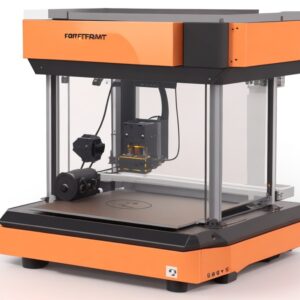Formbot is one such brand that has garnered attention in the 3D printing community. Known for its high-quality, feature-rich printers, Formbot offers a range of models to suit various needs and budgets.
Design and Build Quality

When delving into the design and build quality of Formbot 3D printers, one of the standout aspects is their remarkable emphasis on creating a stable and durable machine. This attention to stability is important as it minimizes vibrations that could otherwise lead to imperfections in the final print. The frame, generally composed of metal, provides a rigid foundation for the entire printing process, enabling the printer to operate smoothly and consistently over long periods. This rigidity is also important when printing at higher speeds or with materials that are more prone to warping or shifting.
The presence of a direct drive extruder in many Formbot models is another significant design feature that enhances the printing experience. This type of extruder allows for a shorter path between the hot end and the filament drive mechanism, reducing the chance of filament buckling or jamming, which is a common issue in bowden-style setups where the filament path is longer and more convoluted. A direct drive system shines particularly when handling flexible and soft filaments, such as TPU or flexible PLA, providing users with a broader spectrum of printing material options and encouraging experimentation with different types of filaments for various applications.
The direct drive extruder’s close proximity to the hot end allows for more precise extrusion control, which is beneficial for intricate prints with fine details or complex geometries. This advantage can be particularly appealing to users interested in creating detailed miniatures, functional prototypes, or art pieces with high-resolution features.
The build area, or print bed, of Formbot 3D printers, ranges in size across different models which cater to the diverse needs of the user base. For hobbyists or those with limited space, smaller models offer a compact footprint without sacrificing print quality. For professionals or enthusiasts engaged in larger projects, Formbot provides models with expansive build volumes to accommodate substantial prints like costume pieces, large-scale models, and architectural prototypes. The print bed usually features a heated surface, which ensures better adhesion of the first print layers and reduces issues such as warping when working with materials sensitive to temperature changes.
The design of the printer is typically complemented by additional features like auto-bed leveling, which contributes to a more user-friendly setup process by simplifying the calibration needed before starting a print. Some models also offer dual extruders, expanding capabilities to print in multiple colors or materials simultaneously.
The design and build quality of Formbot 3D printers reflect a commitment to creating a robust, reliable machine capable of meeting the demands of both casual users and professional-grade projects. The combination of solid construction, versatile extrusion capabilities, and a range of build volumes appeal to those who take their 3D printing seriously and expect a level of performance that matches their investment.
Advantages
Precision Printing: Formbot printers are designed to deliver high-precision prints, making them suitable for detailed models and intricate designs.
Wide Range of Materials: with a high-temperature extruder and heated bed, they can work with a variety of filaments, from basic PLA and ABS to more advanced materials like TPU, PETG, and composites.
Upgradability: many Formbot printers are open to upgrades and modifications, which is great for users who like to tinker and customize their machines.
Active Community: The Formbot user community is active and helpful, making it easier to find support and share knowledge about tweaks and improvements.
User-Friendly Features: features like touchscreen interfaces, filament runout sensors, and power-resume function provide a more user-friendly experience.
Disadvantages
Initial Setup: some users may find the initial setup and calibration of Formbot printers to be somewhat complex, especially if they are new to 3D printing.
Cost: While offering a good value for their features, Formbot printers tend to be more expensive than entry-level options, which might be a barrier for those on a tight budget.
Availability: depending on your location, purchasing a Formbot printer and getting after-sales support might not be as straightforward as with more widely available brands.
Software: though compatible with popular slicing software, some users might prefer a more tailored software experience that is fully optimized for the hardware.
Price: The pricing of Formbot 3D printers varies based on the specific model and features. Entry-level models might be accessible for those with a moderate budget, while more advanced models with larger build volumes and enhanced features could represent a significant investment. The price generally reflects the quality and capabilities of the printers, positioning them as a mid-range to high-end option in the market.
The Formbot 3D printer range offers robust and feature-packed options for those who are serious about their 3D printing. Users who prioritize print quality, material versatility, and the option for future upgrades will find Formbot’s offerings particularly appealing. The higher price point may deter some, but for others, the investment may be justified by the printers’ performance and durability. With an active community for support, Formbot establishes itself as a reputable name for hobbyists and professionals searching for a reliable 3D printing solution. Before making a purchase, it’s recommended to assess individual needs and to compare Formbot models to ensure the best fit for one’s applications and budget.

